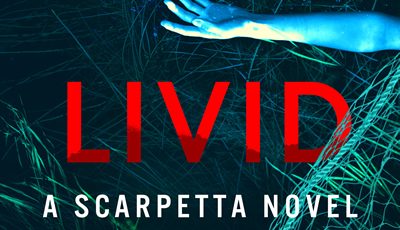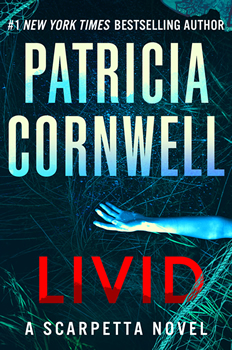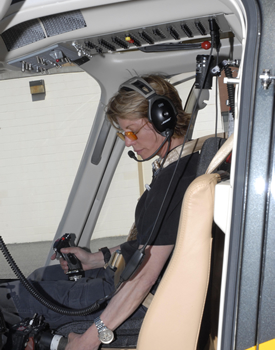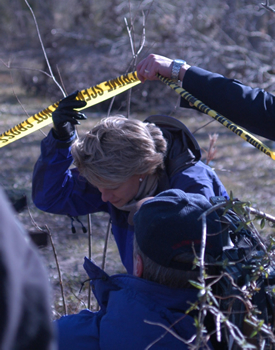

Features Up Close: Patricia Cornwell
Making the World a Better Place
 By Dawn Ius
By Dawn Ius
The year 2017 was a dark one for many thriller aficionados. In 25 years, it was the first without a Dr. Kay Scarpetta book—the first time since 1989’s Postmortem that New York Times bestselling author Patricia Cornwell didn’t release a book in the groundbreaking series that had in many ways revolutionized the genre.
It’s not that Cornwell wasn’t writing. In fact, she penned perhaps one of the most in-depth works of nonfiction on famed serial killer Jack the Ripper, and she spent years researching at NASA before launching a riveting space thriller series featuring Captain Calli Chase.
These books sold well and filled Cornwell’s creative well for a while, but even Captain Chase—who had arguably one of the coolest jobs of fighting crime in space—didn’t quite endear herself to readers the way Chief Medical Examiner Kay Scarpetta had.
Has.
Turns out, Cornwell felt the void as well, and in 2021 gave us Autopsy, the 25th installment of the series—and this year, a new book and a revitalization plan primed to remind readers of why Scarpetta resonates on such a deep and emotional level.
“I think people relate to her for different reasons,” Cornwell says. “For me, she’s a bit of an idealized version of what I would want a role model or hero to be like. I don’t know anyone exactly like her—because there is no one else like her. But there should be because the way the world is going, a lot more business is coming her way—and not the kind of business she wants.”
But taking care of business—forensic business—is what Scarpetta does, and in the latest series instalment, LIVID, she’s got a lot on her plate. The book kicks off with Scarpetta on the stand as a reluctant witness in a sensational murder trial when she receives shocking news—the judge’s sister has been found dead.
At first blush, it looks like a home invasion gone terribly wrong, but things aren’t adding up for Scarpetta. Nothing was stolen, and the garden is strewn with dead plants and insects.
“When Scarpetta approaches a crime scene, she always approaches it from the back side in,” Cornwell says. “And the first thing she notices here is that there are weird things going on with the foliage. It’s like something out of a horror movie. That begins to be her first clue about what happened and gives her an idea about what she should be looking for next. A lot of other people would have pulled into that crime scene and not seen that. They would have marched straight inside to see the body.”
This attention to detail, Cornwell says, is one of the reasons Scarpetta is a hero—she doesn’t miss much. If you’ve got her with you, you know she’ll get to the bottom of things.
That’s true—but in LIVID, her journey takes a few more twists than usual, and the path is a bit more gruesome. For one thing, Cornwell takes us deep into the autopsy room, showing a bit more gore than in previous installments. You feel like you’re standing in the room with that body—which is exactly what Cornwell wants.
Next, there’s a lot going on in LIVID. Plots against the president, corruption on all levels of government, personal threats against Scarpetta—and a terrifying weapon the likes of which Scarpetta and her team have never seen.
“Sometimes the enemy is not what you see, but what you don’t see,” Cornwell says.
If that sounds a little cryptic, it’s meant to be—because at the core of LIVID is a message about the dangers of misinformation, something Cornwell believes could be the ultimate weapon, especially when so much of it is at our virtual fingertips.
“No matter what you’re told to believe, you’re supposed to deny all of it,” she says. “And that’s an incredibly anarchist way of thinking.”
To combat some of that misinformation, and to authenticate the “enemy” in LIVID, Cornwell employed her usual boots on the ground research methods. She spent time with real people—secret service agents, cyber investigators, NASA scientists—to learn about what they deal with outside of what we typically read about in the news.
“When you think of the Secret Service, all you hear about is January 6,” Cornwell says. “What you don’t hear about is their cyber investigations. They’re dealing with very high-tech things. The big enemies out there aren’t just counterfeiting $100 bills anymore. They’re holding companies hostage. They’re tampering with satellites. They are creating new biological and chemical warfare. Scarpetta has to know about these things.”
Learning about these things herself is one of the reasons Cornwell took a small hiatus from the Scarpetta books. After Chaos, Cornwell felt she’d run out of tricks. She didn’t know enough about how advanced technology was changing the world, for the better and worse, and she realized she needed to if she were to keep Scarpetta relevant. That led to her work at NASA—which of course, spawned a short new series, but it also helped her better understand new ways of telling stories.
“The ’90s had its own personality,” she says. “We were worried about serial killers. Now we’re worried about different things—mass shootings, viruses, toxins, nuclear weapons. When Mary Shelley was writing Frankenstein, they were concerned about what technology was going to do to humankind. Stories about monsters were a veiled attempt to point the finger at real monsters. What we’re dealing with now is next level.
And so I need Scarpetta to live in the same world we do, because I think the world is a better place with her in it.”
We couldn’t agree more.
- On the Cover: Alisa Lynn Valdés - March 31, 2023
- On the Cover: Melissa Cassera - March 31, 2023
- Behind the Scenes: From Book to Netflix - March 31, 2023



